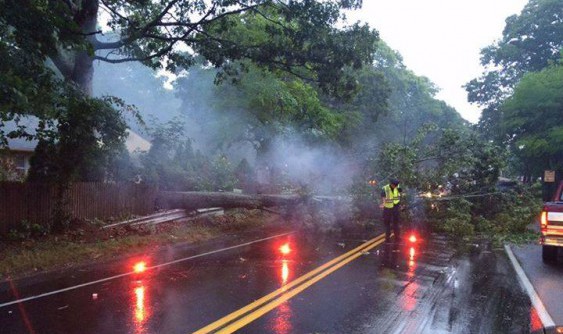With a thunderclap, Syosset residents awoke long before dawn to witness what looked like a strobe light outside as flashes of lightning illuminated the darkness. In East Northport, thunder rattled the windows—and the storm was just getting started. The weather system strengthened rapidly in its steady march across the North Shore, slamming into Stony Brook, St. James and the Three Village area.
On Tuesday morning, Long Islanders saw scenes reminiscent of Superstorm Sandy. Large, old-growth trees blocked the streets, utility poles were snapped, Long Island Rail Road service was disrupted, and around 68,000 Long Islanders found themselves without power. By 5 p.m. the following day, an estimated 21,000 remained without power in the hardest hit areas as restoration efforts lasted well into the night.
The Town of Brookhaven was slammed so badly—and the restoration effort handled so ineffectively—that Town Supervisor Ed Romaine issued a press release excoriating PSEG Long Island. He said the utility had promised to provide six repair crews but as of 4 p.m. he said that only two crews had been dispatched to the town.
“Our residents deserve a quick response to this local disaster,” Romaine said.
The powerful predawn thunderstorm exposed the glaring weakness of our region’s aging infrastructure. Once again, LI had a rude awakening. Our antiquated overhead wires, those pregnable pole-mounted transformers and a utility not up to the task of adequately serving the needs of our region.
“The amount of damage and the widespread nature of such is not too common, and doesn’t happen too often,” said Michael Leona, a professional freelance meteorologist. “I believe this is the most widespread damage on Long Island since Sandy.”
Prior to Tuesday’s destruction, he said that the most recent non-tropical storm damage was from a powerful nor’easter in March 2010 that affected southern Nassau County.
Leona observed that severe thunderstorms packing what are called straight-line winds of 70-90 mph are not common here. He declined to suggest whether this system represented the “new normal” weather pattern but said that Long Islanders are certainly more attuned to what’s occurring in the air and on the ground thanks to social media and smartphones.
“I don’t know if stronger storms are happening more often,” Leona told me, “but the public will know about it extensively and very quickly.”
Leona touches upon an interesting trend. It seems that Long Islanders have more awareness of the weather, and thanks to bursts of severe occurrences—be they blizzards, nor’easters, thunderstorms or large-scale extreme events like hurricanes and tornadoes—more attention is being given to the impacts these storms have. On the regional level, storm preparation has spurred fortification of coastal areas, elevation of houses on the South Shore and even condemnation of properties on Fire Island to make way for protective dunes. Yet, despite these measures, our infrastructure, especially our power lines, remain vulnerable.
For Long Islanders, it is an all-too-familiar scenario. A storm hits, trees topple and the lights go off, but it is too easy to place blame solely on PSEG Long Island, mainly because the Island’s storm vulnerability long predates their oversight of the grid. By continuing to expand and rebuild out antiquated method of power delivery, we shall continue to ensure that whenever the strong winds blow, darkness will result.
Unfortunately, the solution to our electricity woes is both complex and very costly.
According to News 12 Long Island, “An independent study commissioned by LIPA in 2005 found that burying wires on Long Island could cost $25 to $30 billion. The study says it would raise electricity rates by 150 percent over 25 years.”
Long Islanders know all too well how utilities in the region handle large-scale projects and debt management, so the political will to move forward will be weak at best. But that doesn’t mean burying the lines isn’t necessary.
A small, yet effective step easy to implement would be for local governments to mandate that new residential subdivisions place their power lines underground. While most of Nassau and western Suffolk counties is predominately built up, this requirement would at least ensure some resiliency from eastern Brookhaven to points eastward.
This thunderstorm was rare, but it wreaked havoc on North Shore communities. Policymakers should look at the big picture. As devastating as Superstorm Sandy was for LI, it barely classified as a Category 1 on the Saffir-Simpson Hurricane Wind Scale. The September 1938 hurricane dubbed “The Long Island Express,” which carved out the Shinnecock Inlet and shattered the East End, was a Category 3.
Yes, Sandy was weak by comparison, yet we’re still feeling its impacts. The recent thunderstorm was even weaker, and thousands of Long Islanders remained without power for two days afterwards.
We need to start seriously exploring where, and why, our electrical grid is vulnerable against storms—and enact workable solutions. Additional tree-trimming and maintenance efforts, paired with new requirements for buried power lines, are a good place to start. Once the grid is adequately assessed, we can address the weakest points in the grid and ensure that when the next bad storm comes, the lights will stay on.
What will it take for Long Island to be ready? Let’s not wait another day to find out.
Rich Murdocco writes about Long Island’s land use and real estate development issues. He received his Master’s in Public Policy at Stony Brook University, where he studied regional planning under Dr. Lee Koppelman, Long Island’s veteran master planner. Murdocco is a regular contributor to the Long Island Press. More of his views can be found on www.TheFoggiestIdea.org or follow him on Twitter @TheFoggiestIdea.



























